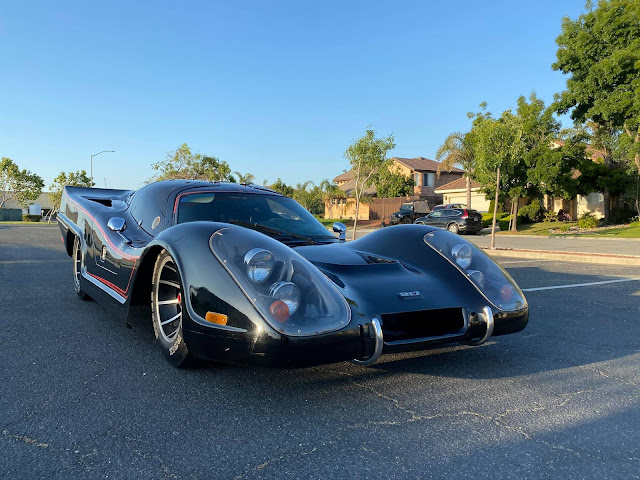 |
The Elite Laser 917, owned by Vic Sin
|
Gerry Knapp founded Elite Enterprises November of 69 in Cokato, Minnesota. In 1972 Elite Enterprises introduced one of the most popular kits of it's era, the Laser 917. Based on the Le Mans winning Porsche 917 of racing fame, the Laser was designed to fit on a full length VW Bug or Karmann Ghia chassis.
It featured a very curvaceous body penned by the west coast designer, illustrator, and transportation design instructor at Art Center College of Design (in Pasadena CA.), Harry Bradley. While not an exact replica, the 917 was more of a stylized caricature of the original. It was certainly a striking ride. With it's low, wide stance and gull-wing doors it was a guaranteed head turner!
 |
A replica of the Laser 917 featured in the film "Herbie goes to Monte Carlo".
|
The Laser 917 even attained movie stardom in the 1977 blockbuster, "Herbie Goes to Monte Carlo". Driven by mustachioed, German, racing driver "Bruno Von Stickle", played by Eric Braeden. In the film, Von Stickle’s car was painted in the colors of the German national flag and given the number 17. Unsurprisingly, the Beetle got the better of it on the silver screen…
The kit came in 3 packages with varying degrees of completeness. Some welding and minor modification to the Bug floor-pan was called for, however, an elaborate builder's manual with over 500 pictures and diagrams was included to make things easier.
Elite claimed the kit could be built in 100 hours. That sounds unlikely, to be honest. It was a very solid sturdy kit though, with the body molded in one piece. Only the doors and rear engine compartment lid were left to mount. The interior kit included VDO gauges, adjustable fiberglass bucket seats, and vinyl padded upholstery in 3 color options. In '79 the complete package was $5,000.
 |
An image from a vintage Elite advertisement
|
As an aside, Chrysler Motor Corporation actually had to buy the rights to the "Laser" name because they planned to release their own car using the same moniker. Negotiations resulted in a Licensing Agreement for the use of the name Laser between Elite Enterprises Inc. and Chrysler on September 13, 1982.
In the mid 80's Elite folded, due to the untimely death of it's founder, and a company called Quint Enterprises took over marketing of the car. Quint soldiered on until 1991. In the end, 679 units were made, which is an impressive run by specialty car standards.
This article appeared in the original version of the Rare Component Cars e-zine in 1998, hosted by the late Shannon Larratt of Priceofhistoys.com, but has been updated with additional detail and photos courtesy of Vic Sin.
 |
| The Elite Laser 917 |
 |
| The Elite Laser 917 open for business |
 |
| The Elite Laser 917 |
 |
| The Elite Laser 917 with classic Gulf Oil livery |
 |
| The Elite Laser 917 with period correct 'turbo vane' wheels |
 |
An excellent example of the Elite Laser 917,
owned by Facebook user Vic Sn. |
 |
An excellent example of the Elite Laser 917,
owned by Facebook user Vic Sn |
 |
An excellent example of the Elite Laser 917,
owned by Facebook user Vic Sn |
 |
Interior of the Elite Laser 917,
owned by Facebook user Vic Sn |
 |
| The Elite Laser 917, open for business |
 |
| The Elite Laser 917 in an attention grabbing color |
 |
| The Elite Laser 917 with a custom rear 'clamshell' |
 |
A typical engine bay in the Laser 917
|
 |
| Vic Sin's Elite Laser 917 |
 |
| The interior of Vic Sin's Elite Laser 917 |
 |
A very period correct build of the Laser 917, in NYC
|























Comments
Post a Comment